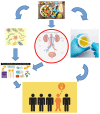Current Viewpoint on Female Urogenital Microbiome-The Cause or the Consequence?
- PMID: 37317181
- PMCID: PMC10224287
- DOI: 10.3390/microorganisms11051207
Current Viewpoint on Female Urogenital Microbiome-The Cause or the Consequence?
Abstract
An increasing amount of evidence implies that native microbiota is a constituent part of a healthy urinary tract (UT), making it an ecosystem on its own. What is still not clear is whether the origin of the urinary microbial community is the indirect consequence of the more abundant gut microbiota or a more distinct separation exists between these two systems. Another area of uncertainty is the existence of a link between the shifts in UT microbial composition and both the onset and persistence of cystitis symptoms. Cystitis is one of the most common reasons for antimicrobial drugs prescriptions in primary and secondary care and an important contributor to the problem of antimicrobial resistance. Despite this fact, we still have trouble distinguishing whether the primary cause of the majority of cystitis cases is a single pathogen overgrowth or a systemic disorder affecting the entire urinary microbiota. There is an increasing trend in studies monitoring changes and dynamics of UT microbiota, but this field of research is still in its infancy. Using NGS and bioinformatics, it is possible to obtain microbiota taxonomic profiles directly from urine samples, which can provide a window into microbial diversity (or the lack of) underlying each patient's cystitis symptoms. However, while microbiota refers to the living collection of microorganisms, an interchangeably used term microbiome referring to the genetic material of the microbiota is more often used in conjunction with sequencing data. It is this vast amount of sequences, which are truly "Big Data", that allow us to create models that describe interactions between different species contributing to an UT ecosystem, when coupled with machine-learning techniques. Although in a simplified predator-prey form these multi-species interaction models have the potential to further validate or disprove current beliefs; whether it is the presence or the absence of particular key players in a UT microbial ecosystem, the exact cause or consequence of the otherwise unknown etiology in the majority of cystitis cases. These insights might prove to be vital in our ongoing struggle against pathogen resistance and offer us new and promising clinical markers.
Keywords: Big Data; NGS; UT microbiota; bioinformatics; cystitis; machine learning.
Conflict of interest statement
The authors declare no conflict of interest.
Figures


References
-
- Price T.K., Dune T., Hilt E.E., Thomas-White K.J., Kliethermes S., Brincat C., Brubaker L., Wolfe A.J., Mueller E.R., Schreckenberger P.C. The Clinical Urine Culture: Enhanced Techniques Improve Detection of Clinically Relevant Microorganisms. J. Clin. Microbiol. 2016;54:1216–1222. doi: 10.1128/JCM.00044-16. - DOI - PMC - PubMed
Publication types
LinkOut - more resources
Full Text Sources

